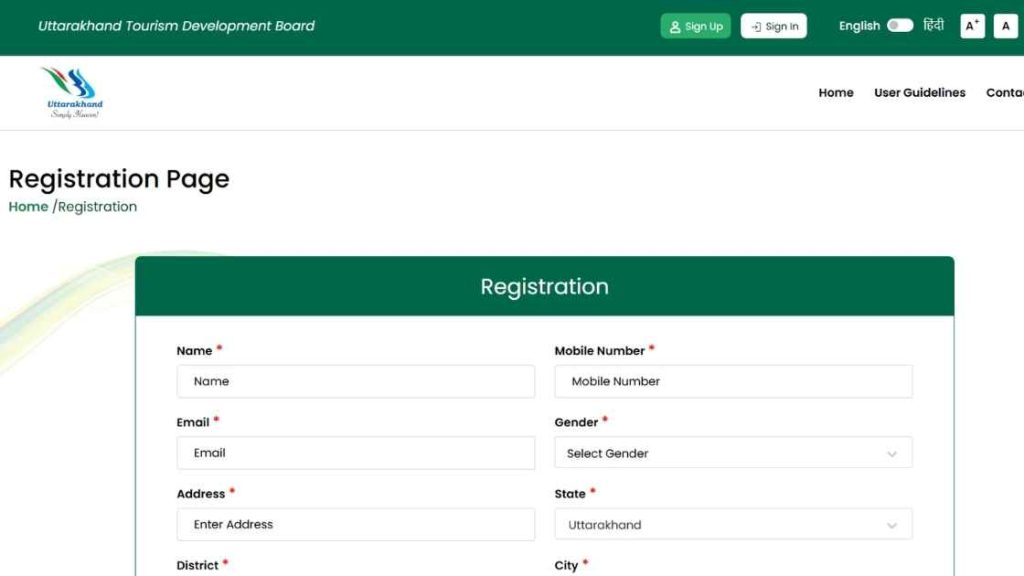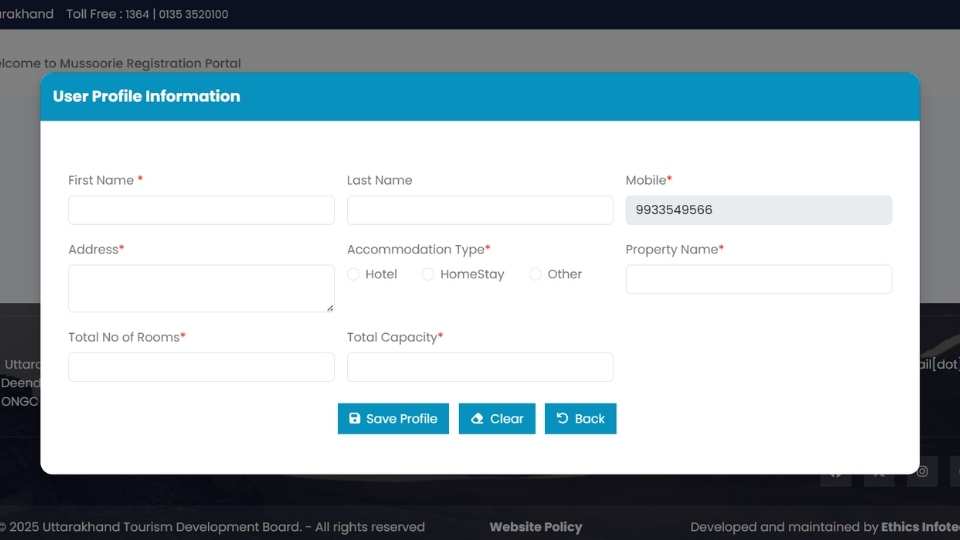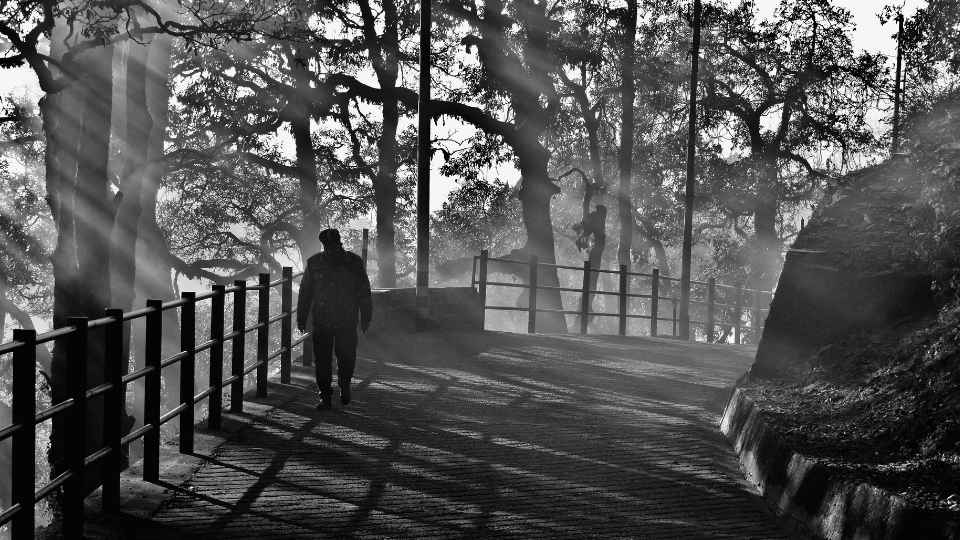Starting August 1, 2025, tourists planning a trip to Mussoorie in Uttarakhand will have to proceed for Mussoorie Tourist Registration online before check-in—a landmark decision taken by the Uttarakhand Tourism Department in a bid to tackle overcrowding, traffic congestion, and ecological strain in the hill station popularly known as the Queen of Hills.
With this mandatory registration system, Mussoorie becomes one of the first hill stations in India to implement a real-time digital tracking system for tourist inflow, taking cues from the successful Chardham Yatra registration model.
Table of Contents
Why Has This Step Been Taken?
The move follows a dramatic increase in tourism numbers—from 11 lakh tourists in 2022 to over 21 lakh in 2024. The town’s fragile infrastructure, narrow roads, limited parking space, and overburdened medical services have all been stretched thin.

Incidents like the tragic death of a tourist from Delhi in June 2024, who couldn’t receive timely medical care due to traffic congestion, have underlined the urgent need for systematic visitor regulation.
District Tourism Officer Brijendra Pandey emphasized:
“This system is being implemented to better manage footfall, ensure safety, and enable long-term infrastructure planning.”
Related: 6 Best Places to Visit in Ladakh with a Detailed Itinerary
What the Mussoorie Tourist Registration Rule Entails
From now on, all tourists visiting Mussoorie and staying overnight in hotels, guesthouses, or homestays must register themselves on a portal developed by the Uttarakhand Tourism Department. The registration is compulsory at the time of check-in. The system applies to:
- Hotels
- Guesthouses
- Homestays
- Other commercial accommodations
Additionally, accommodation providers must also register their properties on the portal before logging in their guest details.
How to Register as a Tourist
Tourists visiting Mussoorie need to complete a simple online registration before arrival:
Step-by-step Process:
- Visit the Registration Portal.
- Sign up or Sign in to the registration form.
- Fill out the online form.
- Domestic tourists will receive a one-time password (OTP) on their mobile number for verification.
- International tourists will receive the OTP via email.
- Upon verification, a QR code will be generated, which tourists must show at entry checkpoints like Kimadi, Kempty Falls, and Kuthal Gate.

ANPR (Automatic Number Plate Recognition) cameras will simultaneously verify vehicle details.
How Accommodation Providers Must Comply
All hotels, guesthouses, and homestays in Mussoorie must also register their properties on the tourism portal. The information they need to submit includes:
- Name of the property
- Type of facility (hotel, homestay, etc.)
- Number of rooms
- Maximum guest capacity
- Name and contact information of the owner

Once registered, they are mandated to record each guest’s check-in details on the portal in real-time.
District Tourism Officer Pandey said:
“We are collecting this data not just to count visitors, but to aid in strategic infrastructure development, crowd control, and emergency management.”
Related: 7 Best Places to Visit in Asia in August for Sun, Culture & Nature
Backed by the National Green Tribunal (NGT)
The implementation of the registration rule comes in direct response to a May 2025 directive by the National Green Tribunal (NGT). The NGT ordered the Uttarakhand government to regulate tourist flow in Mussoorie and regularly submit visitor data to avoid environmental degradation and infrastructure strain.
The NGT had previously issued warnings after land subsidence incidents in Joshimath and expressed concern over Mussoorie’s “carrying capacity” — defined by available parking, waste management, medical services, and road conditions.
Administrative Perspectives: More Than Just Crowd Control
According to Dhiraj Singh Garbyal, Secretary of the Tourism Department:
“This is not to deter tourists, but to ensure sustainable and organized tourism. We will monitor how the system performs in Mussoorie and consider expanding it to other tourist-heavy areas in Uttarakhand.”
The government is also developing a separate route and registration plan for transit visitors, such as pilgrims on their way to Chardham Yatra.
Related Article: Ranchi – A Refreshing Place to Visit in Monsoon
Industry Reactions about Mussoorie Tourist Registration: Mixed Responses
Not everyone is on board. While some hoteliers and associations have welcomed the move, others fear it might hurt local businesses.
Sanjay Aggarwal, President of the Mussoorie Hotel Association, expressed support:
“This will bring organization to Mussoorie’s tourism model. We are advising our members to help tourists with on-the-spot registration.”
However, Arun Verma, President of the Almora Hotel Association, expressed concern:
“Look at what’s happening in Kainchi Dham. Traffic jams have already destroyed our businesses. If this registration system spreads to low-volume areas like Almora or Kausani, we’ll be wiped out.”
You may find interesting: 5 Best Women’s Raincoats for Monsoon
Enforcement Timeline and Flexibility
The tourism department has clarified that initial implementation will be flexible, to ease the transition for both tourists and hospitality providers. However, the system will become stricter during high-traffic periods, such as summer vacations, festivals, and long weekends.
Impact and Expected Benefits
The key objectives behind the registration system include:
- Real-time data collection on tourist numbers
- Improved traffic management
- Better emergency service planning
- Eco-sustainability and conservation
- Improved waste and parking management
Already, the town has been suffering from long traffic snarls—especially on the Gandhi Chowk to Mall Road stretch. In June 2024, a patient in an ambulance stuck in a jam reportedly died due to delay in medical help—a tragedy that served as a wake-up call for authorities.
Related: Top 12 Safe Monsoon Destinations in India
A Glimpse Into the Future
If the registration system proves successful in Mussoorie, the government is likely to expand this framework to other tourist spots like Nainital, Rishikesh, Haridwar, and Kedarnath base towns. This marks a broader shift towards regulated and sustainable tourism in Uttarakhand, which is facing mounting environmental pressure from over-tourism.
Conclusion
The newly enforced Mussoorie Tourist Registration system is a proactive attempt by the Uttarakhand government to regain control over the rapidly growing tourism numbers that threaten the town’s natural and civic equilibrium.
Whether it proves to be a blueprint for sustainable tourism or becomes a bureaucratic challenge will depend on how well authorities and stakeholders collaborate in its implementation.
For now, visitors heading to Mussoorie should remember:
No registration, no check-in.
Plan ahead, register early, and help protect the Queen of Hills.
Related Sources: India TV, DNA India







